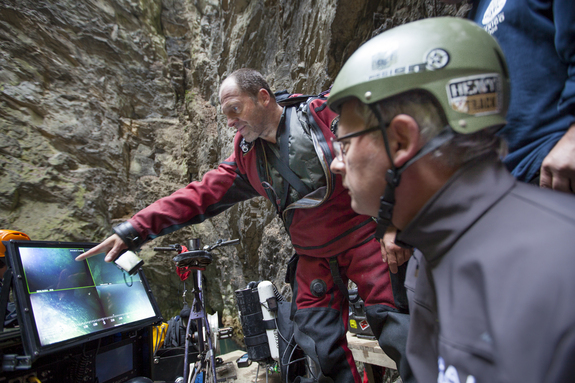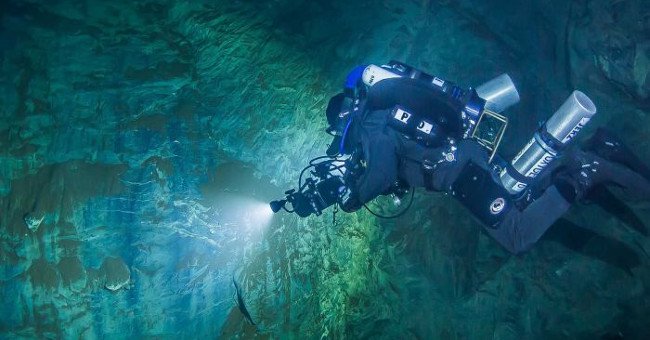Explore the world's deepest underwater caves in the Czech Republic
People combine with robots to discover the world's deepest underwater cave in the Czech Republic. This cave, called Hranická Propast, reaches a dizzying depth of 404m (1,325 ft), deeper than the second deepest cave in the world, Pozzo del Merro in Italy, about 12m.

Polish diver Krzysztof Starnawski began diving at Hranicka Propast and identified it as the deepest cave in the world 20 years ago.(Image source: Marcin Jamkowski / National Geographic).
The Polish diver - Krzysztof Starnawski first discovered the Hranická Propast cave in 1999. The limestone terrain structure he found made him believe that the cave could be much deeper than the location. He can dive to. So Starnawsk divers led the Czech expedition - Poland to explore this cave, supported in part by National Geographic. This expedition team has dived many times down the Hranická Propast cave in the past two years to gather more data. Recently, this limestone basin has been measured by the support of a remote operator vehicle (ROV) and identified the deepest Hranická Propast cave in the world.
On a 2014 dive, Starnawski dived to a depth of 200m (656 ft) - where he thought it was the bottom of the cave. However, he found a narrow hole leading to an enlarged tunnel, far beyond the probe that Starnawsk used to measure the depth of the cave. The depth of this tunnel is about 384m (1260 ft), only slightly lower than the water depth of Pozzo del Merro 392m.
"Krzysztof Starnawski is a diver in very deep caves, so he is very passionate about exploring the deepest parts of this cave system ", Marcin Jamkowski - a member of the expedition and also a home explorer film - answered the Live Science newspaper.

With the help of an underwater remote control, the expedition team can measure the depth of this cave and explore the bottom of this limestone abyss.(Image source: Marcin Jamkowski / National Geographic)
Returning to the cave last year, Starnawski found that the narrow slots were wider and he could get in to a depth of 265m (869 ft). He dropped another probe, this time the probe could reach "the bottom" at a depth of 370m (1214 ft), which was probably the tip of the debris from collapsed sections.
"In the end, on September 27 a exploration dive determined the actual depth of the cave, breaking the record of the depths of the caves. The expedition used ROV technology to touching down to the bottom of the cave, because the 400m depth was beyond the limits of the diver's compressed air tank, "Jamkowski said.

"There have been a number of dives done by the oil industry, reaching such depths (called" deep diving "), but they last for about a month. done in caves like this, so it was obvious that the choice was to send robots to places where humans could not be reached , " Jamkowski wrote in an email.
According to Jamkowski, as soon as the expedition discovered the depth of the cave, they found fallen trees, wood and branches at the bottom. This shows that this cave has changed from its original shape. With the current structure, there are no debris falling from the entrance of the cave.
They also found that this cave is really big, because it appears a natural stone feature or a line "corroded by spring hot water , " Jamkowski said. The team continues to explore and delve deeper into this cave.
You should read it
- Jailed for destroying Neolithic caves for refuge?
- The world's largest underwater cave system is found on the Yucatan Peninsula
- Discover 10 8000 year old cave paintings in Turkey
- Found 50 human bones in the cave, the result of the worst family slaughter in Scotland
- Discover the world's most horrifying church in the Czech Republic
- Science discovered the new blind fish in the cave Meghalaya dark
- Marvel at 12 picturesque nature pictures
- Two new species of shrimp are found in the Gulf of California cave
May be interested
- Scientists conducted an expedition to explore an ancient forest of 60 thousand years old
 60,000-year-old underwater forest opens many valuable researches in the field of medicine.
60,000-year-old underwater forest opens many valuable researches in the field of medicine. - Update details for Minecraft Caves and Cliffs
 the minecraft 1.17 update also known as minecraft caves & cliffs is scheduled to be released in the summer of 2021 and will come to both bedrock and java edition. in this article, tipsmake will share with you some existing information about the content of this update.
the minecraft 1.17 update also known as minecraft caves & cliffs is scheduled to be released in the summer of 2021 and will come to both bedrock and java edition. in this article, tipsmake will share with you some existing information about the content of this update. - 5 deepest lakes in the world
 topping the list of the world's deepest lakes is lake baikal, with a depth of 1,642m, containing 1/5 of the planet's unfrozen freshwater reserves.
topping the list of the world's deepest lakes is lake baikal, with a depth of 1,642m, containing 1/5 of the planet's unfrozen freshwater reserves. - Instructions to find ores in Minecraft 1.18 Caves and Cliffs
 ore mining was quite simple before the minecraft 1.18 update. players can dig down to y-level 12 to find pretty much any ore they desire. however, this is no longer the case because minecraft caves and cliffs completely overhauled ore spawn locations in the game.
ore mining was quite simple before the minecraft 1.18 update. players can dig down to y-level 12 to find pretty much any ore they desire. however, this is no longer the case because minecraft caves and cliffs completely overhauled ore spawn locations in the game. - Anime World Simulator: Full latest giftcode and how to redeem code
 anime worlds simulator code gives away a series of attractive rewards to players through free giftcodes.
anime worlds simulator code gives away a series of attractive rewards to players through free giftcodes. - How to Survive Underwater in Minecraft, Breathe Underwater
 surviving underwater in minecraft requires careful preparation and good skills. with tips like using bubble columns, carrying water breathing potions and equipping enchantments, you will easily conquer the challenges under the ocean. discover how to survive underwater in minecraft in this article.
surviving underwater in minecraft requires careful preparation and good skills. with tips like using bubble columns, carrying water breathing potions and equipping enchantments, you will easily conquer the challenges under the ocean. discover how to survive underwater in minecraft in this article. - The world's deepest sunken shipwrecks ever discovered
 the famous titanic sank in 1912 at a depth of about 3,810 meters, more than twice the depth of the grand canyon in the us and five times the height of the tallest building in the world, dubai's burj khalifa, but still far from the deepest wreck ever discovered.
the famous titanic sank in 1912 at a depth of about 3,810 meters, more than twice the depth of the grand canyon in the us and five times the height of the tallest building in the world, dubai's burj khalifa, but still far from the deepest wreck ever discovered. - TOP biomes suitable for building houses in Minecraft 1.18 Caves and Cliffs
 with the minecraft 1.18 caves and cliffs update, mojang introduced 8 new biome biomes in their open world survival game. this is the biggest update of the game in a long time, with a new world generation, changes in ore distribution, new biomes
with the minecraft 1.18 caves and cliffs update, mojang introduced 8 new biome biomes in their open world survival game. this is the biggest update of the game in a long time, with a new world generation, changes in ore distribution, new biomes - Close-up of the deepest living fish in the ocean ever recorded by camera
 this is the deepest living fish on the seabed ever recorded. university of western australia deep-sea scientist, professor alan jamieson, said that if this record is broken, it is likely that the depth will only increase by a few meters.
this is the deepest living fish on the seabed ever recorded. university of western australia deep-sea scientist, professor alan jamieson, said that if this record is broken, it is likely that the depth will only increase by a few meters. - Amazon submits the invention of an underwater warehouse to maximize storage space
 why build a warehouse on the ground while there is a lot of underwater space for fully automated warehouses? please join us to see how amazon submits inventions to underwater warehouses to maximize storage space!
why build a warehouse on the ground while there is a lot of underwater space for fully automated warehouses? please join us to see how amazon submits inventions to underwater warehouses to maximize storage space!










 11 famous inventions and inventions of Vietnamese people made the world admire
11 famous inventions and inventions of Vietnamese people made the world admire Science proves: Children inherit intelligence from their mother, not from their father
Science proves: Children inherit intelligence from their mother, not from their father Explain the cause of an electric shock when you bend your elbow on the table
Explain the cause of an electric shock when you bend your elbow on the table Top 10 fastest growing industries in 2016
Top 10 fastest growing industries in 2016 Why do you always feel the way back is shorter than the road?
Why do you always feel the way back is shorter than the road? Suddenly discovered life right in the core of the Earth
Suddenly discovered life right in the core of the Earth